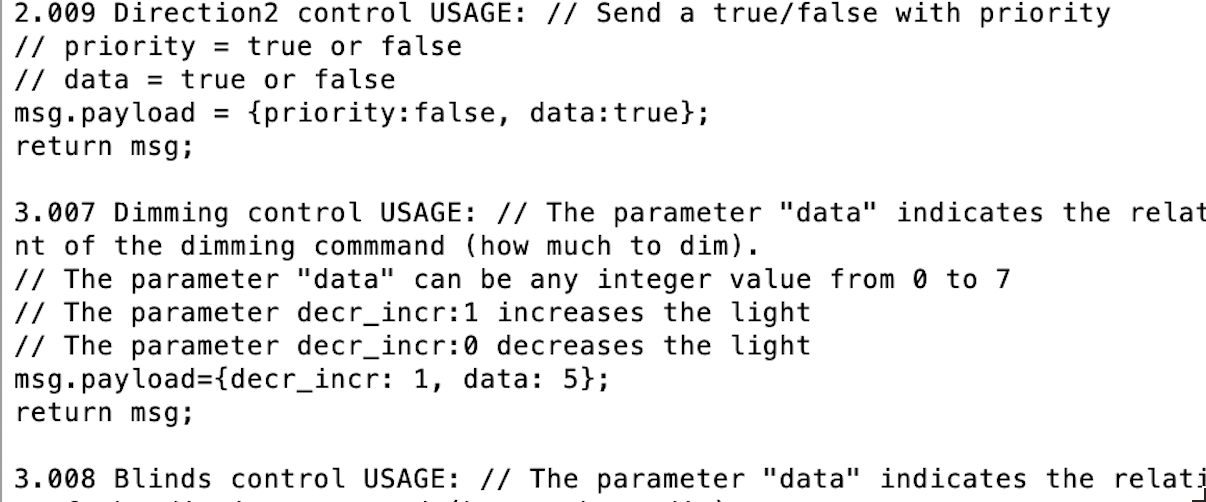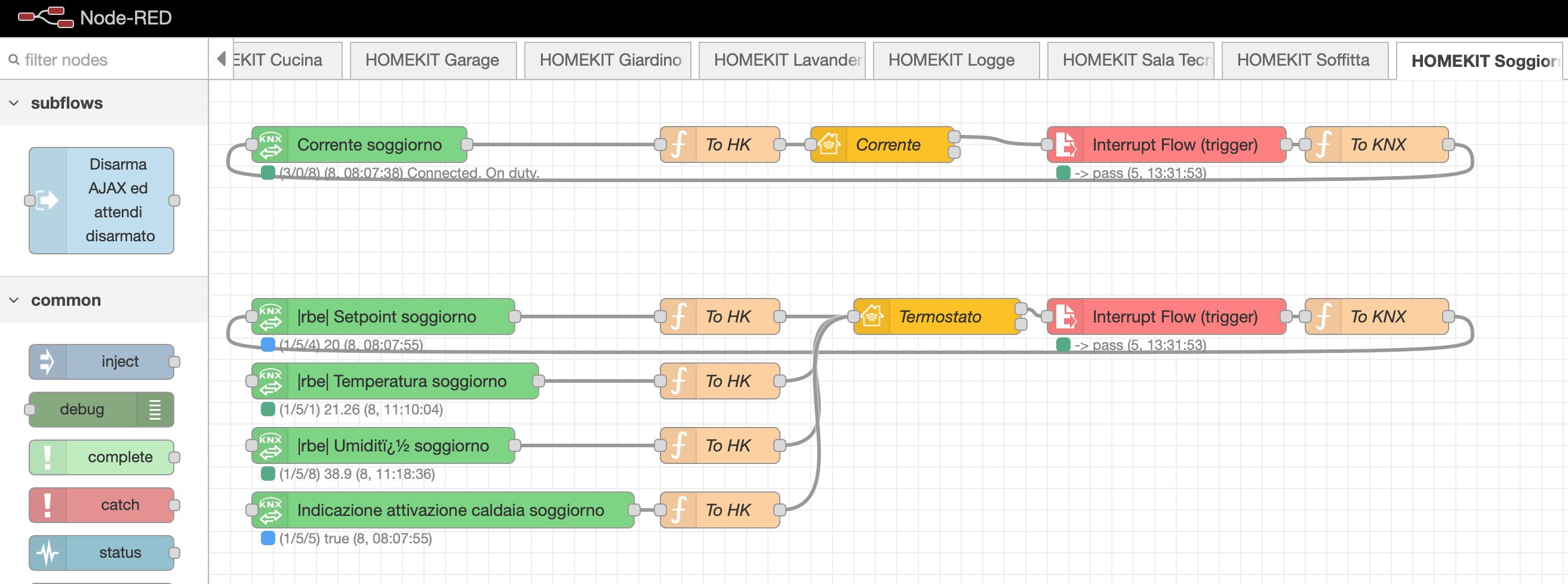Gathering detailed insights and metrics for knxultimate
Gathering detailed insights and metrics for knxultimate
Gathering detailed insights and metrics for knxultimate
Gathering detailed insights and metrics for knxultimate
npm install knxultimateRelease 4.1.0-beta.1
Published on 21 Nov 2024
Release 4.0.0-beta.6
Published on 18 Nov 2024
Release 4.0.0-beta.5
Published on 17 Nov 2024
Release 4.0.0-beta.4
Published on 15 Nov 2024
Release 4.0.0-beta.3
Published on 15 Nov 2024
Release 4.0.0-beta.2
Published on 17 Oct 2024
Module System
Min. Node Version
Typescript Support
Node Version
NPM Version
29 Stars
270 Commits
10 Forks
6 Watching
7 Branches
6 Contributors
Updated on 26 Nov 2024
TypeScript (99.68%)
JavaScript (0.32%)
Cumulative downloads
Total Downloads
Last day
-7.6%
61
Compared to previous day
Last week
-23.2%
601
Compared to previous week
Last month
19.3%
3,381
Compared to previous month
Last year
384.6%
14,620
Compared to previous year
16

Control your KNX intallation via Node.js!
This is the official engine of Node-Red's node node-red-contrib-knx-ultimate
Many of you asked for a node.js release of that engine, so i decided to create this package.
If you enjoy my work developing this package, do today a kind thing for someone too. This will be the reward for my work.

| Technology | Supported |
|---|---|
| KNX Tunnelling | |
| KNX Routing | |
| KNX Secure Tunnelling | |
| KNX Secure Routing |
These are the properties to be passed to the connection as a JSON object {} (see the knxUltimateClientProperties variable in the exsamples)
| Property | Description |
|---|---|
| ipAddr (string) | The IP of your KNX router/interface (for Routers, use "224.0.23.12") |
| hostProtocol (string) | "Multicast" if you're connecting to a KNX Router. "TunnelUDP" for KNX Interfaces, or "TunnelTCP" for secure KNX Interfaces (KNX Secure is not yet implemented) |
| ipPort (string) | The port, default is "3671" |
| physAddr (string) | The physical address to be identified in the KNX bus |
| suppress_ack_ldatareq (bool) | Avoid sending/receive the ACK telegram. Leave false. If you encounter issues with old interface, set it to true |
| loglevel (string) | The log level 'disable', 'error', 'warn', 'info', 'debug' |
| isSecureKNXEnabled (bool) | True: Enables the secure connection. Leave false until KNX-Secure has been released. |
| jKNXSecureKeyring (string) | Optional. ETS Keyring JSON file content. Leave blank until KNX-Secure has been released. |
| localIPAddress (string) | Optional. The local IP address to be used to connect to the KNX/IP Bus. Leave blank, will be automatically filled by KNXUltimate |
| interface (string) | Optional. Specifies the local eth interface to be used to connect to the KNX Bus. |
| KNXQueueSendIntervalMilliseconds | Optional. The KNX standard has a maximum transmit rate to the BUS, of about 1 telegram each 25ms (to stay safe). In case you've a lot of traffic on the BUS, you can increase this value, expressed in milliseconds. Be careful, because if you set it too high, the KNX engine could send a telegram with flag 'repeat', because the ACK from the device is coming too late. |
For each Datapoint, there is a sample on how to format the payload (telegram) to be passed.
For example, pass a true for datapoint "1.001", or { red: 125, green: 0, blue: 0 } for datapoint "232.600".
It support a massive number of Datapoints. Please run the examples/showDatapoints.ts file to view all datapoints in the output console.
Be aware, that the descriptions you'll see, are taken from Node-Red KNX-Ultimate node, so there is more code than you need here. Please take only the msg.payload part in consideration.
You should see something like this in the console window (the msg.payload is what you need to pass as payload):

| Method | Description |
|---|---|
| .Connect() | Connects to the KNX Gateway |
| .Disconnect() | Gracefully disconnects from the KNX Gateway |
| .write (GA, payload, datapoint) | Sends a WRITE telegram to the BUS. GA is the group address (for example "0/0/1"), payload is the value you want to send (for example true), datapoint is a string representing the datapoint (for example "5.001") |
| .writeRaw (GA, payload, datapoint) | Sends a WRITE telegram to the BUS. GA is the group address (for example "0/0/1"), payload is the buffer you want to send, datapoint is a string representing the datapoint (for example "5.001") |
| .respond (GA, payload, datapoint) | Sends a RESPONSE telegram to the BUS. GA is the group address (for example "0/0/1"), payload is the value you want to send (for example true), datapoint is a string representing the datapoint (for example "5.001") |
| .read (GA) | Sends a READ telegram to the BUS. GA is the group address (for example "0/0/1"). |
| . discover() | Sends a discover request on the KNX default multicast port and returns the results as an array. This is an async method. See the example in the examples folder |
| .getGatewayDescription() | Sends a gateway description request. It works after an established connection. The async results will be sent to the descriptionResponse event. There is an example in the examples folder named gatewaydescription.ts . |
| Property | Description |
|---|---|
| .isConnected() | Returns true if you the client is connected to the KNX Gateway Router/Interface, false if not connected. |
| .clearToSend | true if you can send a telegram, false if the client is still waiting for the last telegram's ACK or whenever the client cannot temporary send the telegram. In tunneling mode, you could also refer to the event KNXClientEvents.ackReceived, that is fired everytime a telegram has been succesfully acknowledge or not acknowledge. See the sample.js file. |
| .channelID | The actual Channel ID. Only defined after a successfull connection |
List of events raised by KNXultimate, in proper order. For the signatures, please see the examples folder.
| Event | Description |
|---|---|
| connecting | KNXUltimate is connecting to the KNX/IP Gateway. Please wait for the connected event to start sending KNX telegrams. |
| connected | KNXUltimate has successfully connected with the KNX/IP Gateway. |
| indication | KNXUltimate has received a KNX telegram, that's avaiable in te the datagram variable. Please see the examples. |
| ackReceived | Ack telegram from KNX/IP Gateway has been received. This confirms that the telegram sent by KNXUltimate has reached the KNX/IP Gateway successfully. |
| disconnected | The KNX connection has been disconnected. |
| close | The main KNXUltimate socket has been closed. |
| error | KNXUltimate has raised an error. The error description is provided as well. |
| descriptionResponse | Gather the getGatewayDescription responses. There is an example in the examples folder named gatewaydescription.ts . |
KNXUltimate logging is managed by Winston logger. In case you want to intercept library logs you can use our logStram exported from default entrypoint. Example:
1import { logStream } from 'knxultimate' 2 3logStream.on('data', (log) => { 4 // handle log 5 if(log.level === 'ERROR) 6 console.log(`${log.timestamp} ${log.message}`) 7})
| Field | Description |
|---|---|
| timestamp | ISO formatted date (YYYY-MM-DD HH:mm:ss.SSS) |
| level | Log level in uppercase (ERROR, WARN, INFO, DEBUG) |
| label | Module name in uppercase (specified when creating logger) |
| message | Log message content |
| stack | Error stack trace (only present for errors) |
| Level | Description |
|---|---|
| disable | No logging |
| error | Only logs errors |
| warn | Logs errors and warnings |
| info | Logs normal operations |
| debug | Logs detailed information |
| trace | Most verbose logging level |
For a complete example of logging usage, see logging.ts in the examples folder.
Decoding is very simple.
Just require the dptlib and use it to decode the RAW telegram
1import { dptlib } from "knxultimate"; 2let dpt = dptlib.resolve("1.001"); 3let jsValue = dptlib.fromBuffer(RAW VALUE (SEE SAMPLES), dpt); // THIS IS THE DECODED VALUE
You can find all examples in the examples folder:
If you want to help us in this project, you're wellcome!
Please refer to the development page.
Why not to try Node-Red https://nodered.org and the awesome KNX-Ultimate node https://flows.nodered.org/node/node-red-contrib-knx-ultimate ?



No vulnerabilities found.

No security vulnerabilities found.